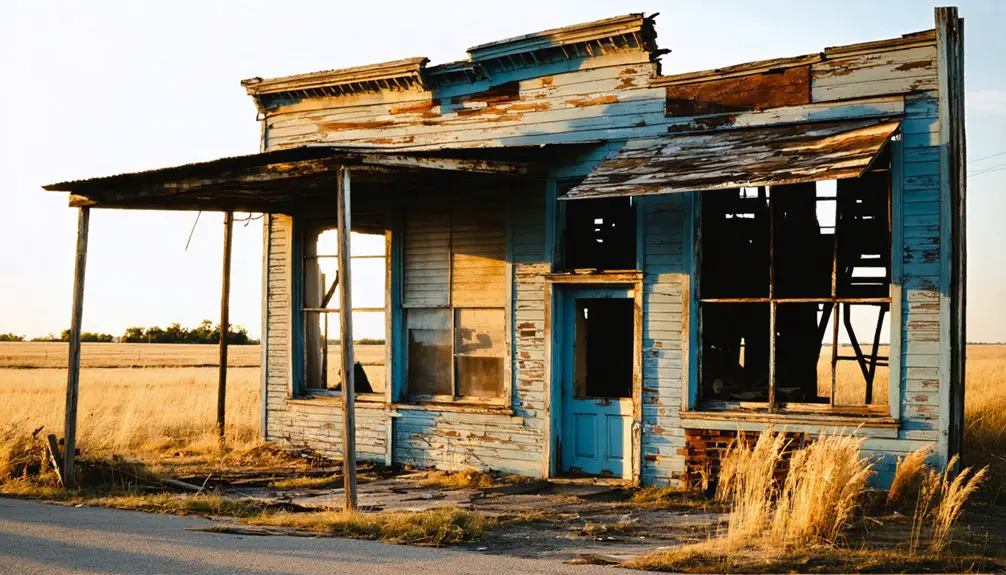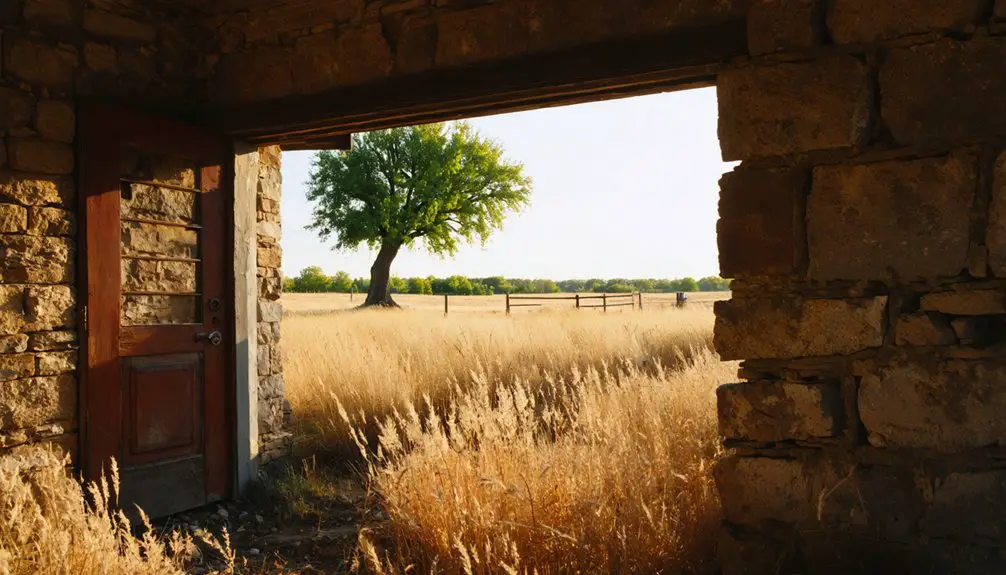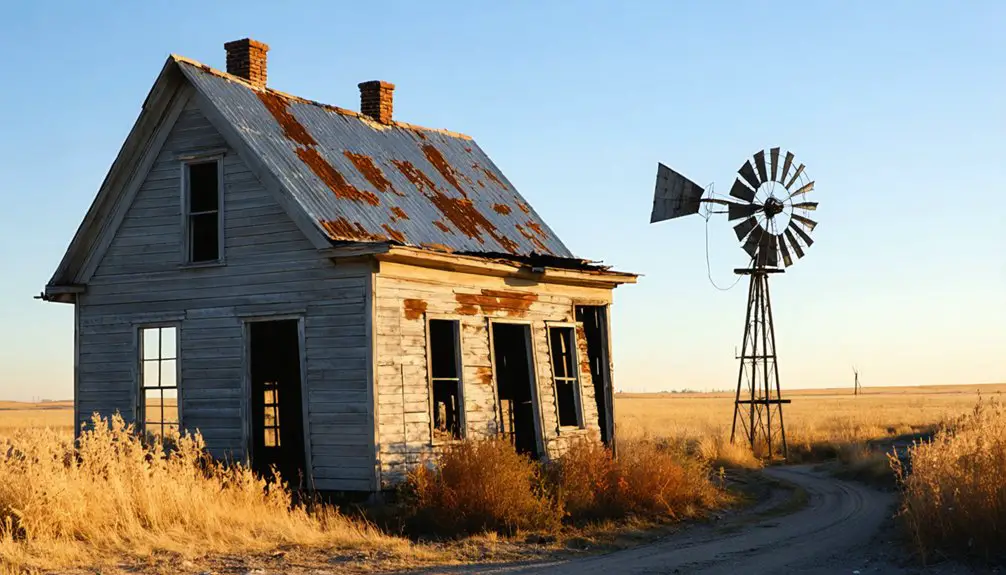You’ll find Jerome’s ghost town remains along Pottawatomie Creek in Anderson County, Kansas, where Dr. George W. Cooper founded this territorial settlement in 1857. The town flourished briefly with sawmills, hotels, and steamboat commerce during Kansas’s tumultuous pre-statehood period. John Brown Jr.’s militia, the Pottawatomie Rifles, protected local abolitionists here. Today, scattered ruins and foundation stones tell a compelling story of frontier ambition, economic shifts, and ultimate decline. The site’s deeper historical layers await your exploration.
Key Takeaways
- Jerome, Kansas was founded in 1857 by Dr. George W. Cooper along Pottawatomie Creek as a planned settlement during Kansas Territory days.
- The town’s early economy thrived on lumber production, with multiple sawmills employing thousands during peak operations.
- Early development included broad streets, wharves, and commercial districts, centered around the Central City Hotel built in 1858.
- Economic decline began in the late 1920s, leading to population exodus, business closures, and eventual abandonment.
- Today, Jerome exists primarily through historical records and scattered abandoned structures that reflect its pioneer past.
Origins and Early Settlement
The frontier settlement of Jerome emerged from Dr. George W. Cooper’s vision when he filed the townsite plat in December 1857, while Kansas was still a territory.
You’ll find Jerome’s community dynamics were shaped by settlers from Iowa who established themselves along Pottawatomie Creek in Reeder Township’s southeastern corner.
Early commerce centered on the lumber industry, with John B. Lambdin and his sons opening the area’s first sawmill to meet growing construction demands.
Lambdin’s pioneering sawmill operation laid the foundation for Jerome’s early economic growth, supplying timber for the expanding frontier settlement.
The Central City Hotel, a prominent two-story structure completed in 1858, marked the town’s first major commercial building.
The town’s strategic location near Pottawatomie Creek promised potential for steamboat traffic, as shown in promotional materials depicting Jerome as a thriving river town.
While several lots sold to landowners, the settlement’s infrastructure developed around basic necessities, with ambitious plans for broad streets and commercial zones marking its initial layout. Like the later town of Jerome, Arizona, which declined from 15,000 residents during its peak years, the Kansas settlement would face its own challenges to survival.
Life Along Pottawatomie Creek
Life along Pottawatomie Creek in the late 1850s centered on a vibrant yet volatile community where settlers faced both opportunity and strife.
You’d find families from Iowa establishing homesteads alongside the creek’s rich ecology, while sawmills operated by entrepreneurs like J.B. Lambdin and C.H. Lowry harvested the area’s timber resources. Led by John Brown Jr., the local militia protected abolitionist settlers while patrolling the region.
Yet beneath this economic activity lay deep settler conflicts. The creek’s waters witnessed the formation of the Pottawatomie Rifles, a 100-strong militia responding to pro-slavery threats, and the infamous Pottawatomie Massacre of 1856, where John Brown’s raid killed five pro-slavery settlers. The brutal attacks left victims’ bodies near the creek, further intensifying territorial tensions.
The violence transformed the creek’s settlements into flashpoints of the “Bleeding Kansas” struggle, even as ambitious plans for Jerome township, with its projected wharves and streets, reflected settlers’ determination to build amid the turmoil.
The Sawmill Industry’s Golden Era
Along Pottawatomie Creek, you’ll find that Jerome’s early sawmill industry flourished through the establishments of J.B. Lambdin, C.H. Lowry, and S.W. Arrant, who operated mills to meet the town’s growing lumber demands.
The creek’s waterpower and the region’s timber resources created ideal conditions for milling operations that supported Jerome’s rapid expansion after its 1857 founding. Similar to operations in Missouri, these mills would soak logs in Toliver-like ponds to clean them before processing.
These sawmills formed a crucial industrial hub, producing dimensional lumber and shingles for local construction while contributing to larger projects like the Kansas Pacific Railroad. The industry employed thousands of workers, with over 1,700 people including teamsters and lumberjacks supporting the operations at peak production.
Early Sawmill Operations Success
During the late 1850s, Jerome’s sawmill industry flourished with J.B. Lambdin and his sons leading the charge, establishing one of the area’s pioneering mills.
You’ll find that sawmill innovations quickly spread, with C.H. Lowry and S.W. Arrant opening additional operations by 1865 along Potawatomie Creek, harnessing water power for their ventures.
These early operators championed timber sustainability through strict 11-inch diameter minimums for harvesting, while implementing sophisticated log-soaking techniques to protect valuable saw blades.
You’d have seen a remarkable mix of circular, band, and head saws at work, powered by water and eventually steam. Their techniques resembled those used at the world’s largest sawmill in Longview, Washington, which would be built decades later in 1929.
The mills’ strategic focus on railroad timber supply, particularly for the Kansas Pacific Railroad, proved essential. Their success attracted workers, supported new settlements, and laid the foundation for Jerome’s rapid growth.
Lumber Demand Sparks Growth
The surging lumber demand of the late 1850s transformed Jerome into a bustling hub of timber production.
You’d have witnessed waves of settlers from Iowa and neighboring states driving an unprecedented need for construction materials as they established homes and community buildings throughout Anderson County.
This explosion in settlement patterns sparked remarkable lumber innovation.
You’ll find that Jerome’s sawmills, led by pioneers like J.B. Lambdin and C.H. Lowry, rapidly evolved from simple water-powered operations to more sophisticated steam-driven facilities.
The mills along Pottawatomie Creek embraced new technologies, including circular saws and efficient conveyor systems, while using their own scrap wood for fuel.
The arrival of rail transport further amplified Jerome’s reach, connecting the town’s lumber production to broader markets and fueling continued growth through the 1860s. These mills maintained impressive production levels, with daily outputs reaching up to 4,700 cubic meters at peak operation.
Pottawatomie Creek Milling Hub
Nestled beside Pottawatomie Creek‘s flowing waters, Jerome’s sawmills formed a vibrant industrial hub that defined southeastern Reeder Township’s early development.
You’d find pioneers like J.B. Lambdin, C.H. Lowry, and S.W. Arrant operating water-powered sawmill technology that transformed local timber into valuable lumber. The creek’s steady flow powered water wheels that drove saw blades, enabling efficient timber processing for the region’s growing construction needs. The mills represented a crucial advancement from ancient hand sawing methods.
- Water-powered mills lined the creek, using renewable energy before steam power’s rise
- Local timber processing supported railroad expansion and town building projects
- Multiple sawmills created jobs and attracted settlers, making Jerome a bustling economic center
These mills weren’t just about lumber – they were freedom engines that helped settlers build their dreams in Kansas Territory.
Town Planning and Development

Founded in 1857, Jerome emerged as a carefully planned settlement in Section 35, Township 20, Range 18 of Anderson County, Kansas Territory. Dr. George W. Cooper’s ambitious vision for the town included detailed lithographs showcasing wharves, steamboats, and a vibrant commercial district along Pottawatomie Creek.
You’ll find the town’s early development was shaped by strategic land ownership patterns, with lots sold to hopeful investors before full development. Local sawmills, including John B. Lambdin’s pioneering operation and later mills run by C.H. Lowry and S.W. Arrant, supplied essential lumber for construction. Like the pioneers who built sod homes in Banner, early settlers worked with available materials to establish their community.
Community engagement flourished through mixed-use planning that incorporated public spaces, churches, and essential services. The town’s design reflected the era’s optimism, with infrastructure planned around waterway commerce and the promise of steamboat traffic connecting Jerome to broader markets.
Economic Changes and Population Shifts
During the late 1920s and early 1930s, Jerome’s once-promising economy faltered as mining operations in nearby regions began to collapse. The town experienced severe economic downturns when smaller mining companies consolidated and copper demand plummeted.
You’ll find that Jerome’s story mirrors many Kansas ghost towns that relied heavily on a single industry.
The resulting population migration devastated the community as residents sought opportunities elsewhere:
- Young families left first, seeking work in larger cities as mechanization reduced agricultural jobs
- Local businesses and banks closed their doors as customer bases dwindled
- Elderly residents who stayed gradually passed away, leaving fewer permanent inhabitants
Transportation changes further isolated Jerome when new highways bypassed the town, making it harder for remaining businesses to attract customers from surrounding areas.
Legacy in Anderson County

While Jerome’s population dwindled to near extinction, its historical significance in Anderson County endures through well-preserved records and local heritage studies.
You’ll find Jerome’s story prominently featured in the county’s historical society archives, where it stands as a reflection of pioneer challenges and early territorial ambitions.
Though the town’s grand plans for steamboat wharves never materialized, Jerome’s impact on regional development can’t be understated.
The settlement’s early infrastructure, including its sawmill, hotel, and stores, helped establish essential commerce along the Lawrence-Humboldt road.
Today, you can trace Jerome’s influence through Anderson County’s historical documentation, which highlights how the town’s strategic location along Pottawatomie Creek shaped local settlement patterns and early economic growth.
Surviving Historical Structures
Jerome’s surviving historical structures tell a compelling tale of its mining-era prosperity and eventual decline.
You’ll discover a town shaped by its mining past, where haunted buildings like the United Verde Hospital, now a hotel, stand as silent witnesses to history. The Liberty Theatre still echoes with ghost stories from its days as a silent film venue, while remnants of the infamous “Cribs District” remind you of the town’s wild reputation.
- The famous Sliding Jail, which literally slid downhill due to mining tunnel cave-ins, remains one of the most unique landmarks.
- Original commercial buildings, once home to saloons and gambling dens, survived despite frequent fires.
- Mining infrastructure beneath the town caused structural shifts that have given surviving buildings their distinctive, precarious character.
Modern Day Remnants

Today, the remnants of Jerome, Kansas stand as a tribute to the harsh realities of Great Plains life and economic transformation. The landscape reflects years of environmental challenges, from devastating tornadoes to persistent drought conditions that have shaped the region’s destiny.
Abandoned buildings and weathered ruins tell a stark tale of survival and surrender in the unforgiving Kansas plains.
You’ll find abandoned structures scattered across the prairie, silent witnesses to the town’s gradual decline.
While exact population figures aren’t readily available, Jerome’s ghost town status reflects broader regional patterns of rural exodus. The harsh climate and shifting economic landscape have left their mark, though there’s potential for ghost town tourism if preservation efforts take hold.
Like many Great Plains communities, Jerome faces the ongoing challenges of soil degradation and water access issues, factors that continue to influence settlement patterns in this unforgiving yet historically rich region.
Frequently Asked Questions
Are There Any Documented Paranormal Activities or Ghost Stories From Jerome?
You’ll discover documented ghost sightings and spectral encounters throughout Jerome, especially at Jerome Grand Hotel, where you can witness hospital apparitions, phantom miners, and a ghost cat roaming the haunted hallways.
What Happened to the Original Town Records and Documents?
You’d think precious town records would be carefully preserved, but they’re likely lost forever – scattered or destroyed during the 1943 military takeover, with no documented historical preservation efforts for Jerome’s archives.
Can Visitors Legally Explore the Jerome Ghost Town Site Today?
You can’t legally access Jerome’s ghost town site since it’s on private property. Unlike Jerome, Arizona’s famous ghost town tourism, the Kansas location doesn’t offer organized exploration or public access.
Which Families Were the Last to Leave Jerome?
You’ll find records don’t conclusively identify the last residents, though historical accounts suggest families connected to sawmills, like the Lambdins, and local landowners maintained family legacies until Jerome’s final decline.
Were There Any Major Crimes or Notable Incidents in Jerome’s History?
You won’t find any major crime reports or significant historical investigations from Jerome. Unlike other Kansas ghost towns that witnessed notable violence, there’s no documented evidence of serious criminal incidents there.
References
- https://our38ftlife.com/2017/01/22/exploring-the-ghost-town-of-jerome/
- https://historyandersoncoks.org/central-city
- https://podcasts.apple.com/us/podcast/midwest-ghost-town/id1726063962
- https://www.youtube.com/watch?v=VPZtNoncnig
- https://legendsofkansas.com/kansas-ghost-town-list/
- https://www.legendsofamerica.com/az-jeromehaunting/
- https://www.onlyinyourstate.com/experiences/arizona/az-ghost-stories-jerome
- https://www.youtube.com/watch?v=xg8SpCG-wDg
- https://civilwaronthewesternborder.org/encyclopedia/pottawatomie-massacre
- https://www.legendsofamerica.com/pottawatomie-rifles/



